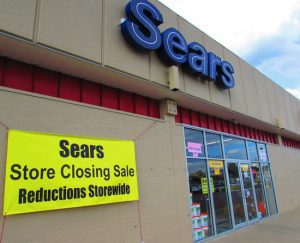 A few weeks ago, I sat down with an old friend. He’s retired now. But when we met 30 years ago, he was a happy, enthusiastic and very upbeat employee in a Canadian retail success story. But when we chatted recently, he shook his head in amazement.
A few weeks ago, I sat down with an old friend. He’s retired now. But when we met 30 years ago, he was a happy, enthusiastic and very upbeat employee in a Canadian retail success story. But when we chatted recently, he shook his head in amazement.
“I cannot believe that Sears is going under,” he lamented. “When I worked there, it seemed as if we’d go on forever.”
In the past few months that former success story has evaporated. What began under the corporate name Simpsons-Sears back in 1953 in Canada, as a combined catalogue and retail store, grew into the national marketplace as one of the largest department chains in the country, competing with Eatons, Simpsons and The Bay. Among the key selling points was the sale of name-brand products, clothing lines and housewares, and the company’s promise: “We service what we sell.”
However, faced with a changing demographic (younger customers) and the onslaught of online purchasing, Sears’ sales began declining. It tried rebranding itself as “Sears 2.0,” but finally, this year, sought protection against creditors, filed for bankruptcy, and began massive liquidation sales.
“Death by Amazon,” one pundit said.
On the weekend, I listened to an open line radio show on the subject and one expert explained that Sears was the author of its own demise. First it closed its appliance repair service wing and let its experienced technicians go. Then it stopped selling parts so that those of us who wanted to try repairing those washers, dryers, bicycles, TV and radios had no replacements to install ourselves. Sears economized to serve its shareholders, and consumers went elsewhere to such services as Kijiji, eBay and Amazon for the answers.
 But it’s not only Sears that’s a victim. With all large retail department stores feeling their necks in the face of this “retail apocalypse,” the entire concept has come under scrutiny by sellers and buyers alike. Perhaps the greatest potential victims are the malls. Once the panacea of shopping for everything under one roof, the mall operators (and the real estate firms that own/collect rent in them) now fear the loss of so-called “anchor” box stores in those malls. Without the anchor, the concept and the shoppers may well drift away.
But it’s not only Sears that’s a victim. With all large retail department stores feeling their necks in the face of this “retail apocalypse,” the entire concept has come under scrutiny by sellers and buyers alike. Perhaps the greatest potential victims are the malls. Once the panacea of shopping for everything under one roof, the mall operators (and the real estate firms that own/collect rent in them) now fear the loss of so-called “anchor” box stores in those malls. Without the anchor, the concept and the shoppers may well drift away.
Question remains: Is online buying the only alternative? I don’t think so. Perhaps I’m a creature of old-fashioned habit, but I prefer buying with my senses, i.e. what I can see, hear, smell, feel and taste. I recognize there must be a tremendous sense of freedom for people with disabilities to purchase perishables and non-perishables via the Internet.
But if I’m shopping for a fitted piece of clothing, a pair of shoes, a piece of hardware, an appliance or even a book, I would rather walk into one of our in-town stores to buy it, not just guess it’ll do, key in my credit card number and demand that it come in the mail 24 hours later! Again, I may be out of step, but I prefer to shop where the sales people know my name (or at least that I’m from nearby), and where they bring additional information about the product I might need into the equation. A couple of times, I’ve had a salesperson recommend I go elsewhere.
The proponents of online shopping claim it will save me money and time I’d spend on gas, parking and wear on my car. They say I can compare prices more easily. They say I can still choose the sizes, designs and colours I like. They say I can shop in the middle of the night, if I choose. And they say I can have the purchase sent to me or as a gift to somebody else … all online.
But are we so driven (sometimes like lemmings) that we can’t afford a moment in the store to mull over, evaluate, maybe get additional product information from a salesperson and then have the satisfaction of having made the right buying decision? Online may be expedient, but think about the implications of more empty storefronts in our town. If the real purchasing option is there, I say, we use the virtual one at our peril.
Amid all the Sears fire-sale announcements I’ve seen these last weeks – with Sears selling everything at up to 50 per cent off and more – the whole issue came home to us this week. Last Friday, I threw some laundry into our clothes washer, added detergent, turned it on and walked away. I heard a thud and turned the machine off. Inside there were chards of plastic from a major part floating in my clothes. Our old Kenmore, we’d bought from Sears way back when, was a goner.
It’s as if our washer sensed Sears’ end was near, and physically and symbolically … gave up the ghost (in time for Halloween). We have been physically shopping for a new one (only online for product evaluations) and prefer it that way.